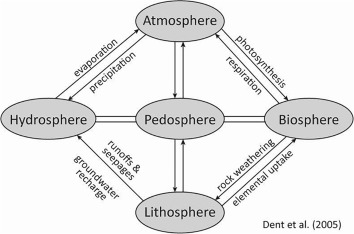Pedosphere
The pedosphere is the uppermost layer of the Earth's crust and is compromised entirely of soil layers. It is the hub that connects the lithosphere, atmosphere, hydrosphere, and biosphere.[1] It is contained within Earth's critical zone, a larger concept including vegetation, groundwater sources, rock layers, and the pedosphere. All terrestrial life on Earth lives on or within the pedosphere.

Pedogenesis
The formation of the pedosphere, or pedogenesis, requires multiple factors, taking from the four different planetary subsystems, or spheres. The air above the soil, living organism interactions, water inside, on top of or below the soil, and unconsolidated, superficial rock deposits. Layer formation begins with mechanical and chemical weathering of minerals in order to form regolith. Organic reactions from biological sources such as lichen and moss increase the rates of decomposition of the initial materials. Once the soil material has accumulated, water enters the system causing nutrient movement and ion exchange. The geochemical makeup of the soil then moves away from the parent material and reflects more of the biological processes taking place. The time it takes for this process to form one inch of soil is 500 years.[2]
Subsphere Interactions
Atmosphere
The gaseous exchange between the pedosphere and atmosphere is at all times in equilibrium. Carbon dioxide is the most commonly exchanged gas between the spheres because of high microbial CO2 production and CO2 release from root hairs. This also causes higher than average bicarbonate (HCO3-) concentration in soil waters. Other exchanges between the two include rainfall and sedimentation via wind erosion/weathering.[4]
Biosphere
Lichens, the pioneer species of soils, begin soil production processes with the secretion of oxalic acid into the regolith. Organic acids from plants are released into the soil layers and perform a process known as chelation.[4] These acid types include acetic acid, citric acid, phenolic acid, humic acid, and fulvic acid. Other inputs from the biosphere include earthworm soil activity, in which they improve fertility by forming humus in soil layers. Animal waste and animal decomposition also add nutrients such as nitrogen and phosphorus to the pedosphere.
Hydrosphere
As water enters the soil parent material, it transports matter around horizontally and vertically throughout the pedosphere. Water is consumed by fauna inside the pedosphere, allowing for the biosphere to begin its processes within the soil. Higher amounts of soil water are linked to higher rates of chemical weathering, and soil water volume shapes the formation of soils.[3] Different environments house different amounts of precipitation and groundwater, leading to stark differences between their clay types, e.g. rainforest soils are high in water causing high amounts of chemical weathering, leading to higher decomposition rates and the inability for podsolisation to take place, leaving mobile metals to form oxides. This gives tropic soils brighter reddish colors.
Lithosphere
Lithospheric interactions form the base for pedosphere creation, and lithosphere composition determines available material for soil formation. As rock material is weathered and regolith forms and builds up, it allows for lichen to begin further breaking down of material.
References
[1] Levine, Alissa. Soil Science Education - The Pedosphere as a Hub. 21 July 2012, https://web.archive.org/web/20120721040417/http://soil.gsfc.nasa.gov/index.php?section=75.
[2] Soil Formation | NRCS Washington. https://www.nrcs.usda.gov/wps/portal/nrcs/detail/wa/soils/?cid=nrcs144p2_036333. Accessed 25 Apr. 2022.
[3] Meharg, Andrew A., and Caroline Meharg. “The Pedosphere as a Sink, Source, and Record of Anthropogenic and Natural Arsenic Atmospheric Deposition.” Environmental Science & Technology, vol. 55, no. 12, June 2021, pp. 7757–69. ACS Publications, https://doi.org/10.1021/acs.est.1c00460.
[4] Targulian, Victor O., et al. “Pedosphere☆.” Encyclopedia of Ecology (Second Edition), edited by Brian Fath, Elsevier, 2019, pp. 162–68. ScienceDirect, https://doi.org/10.1016/B978-0-12-409548-9.11153-4.